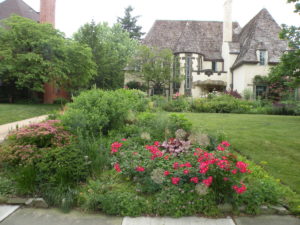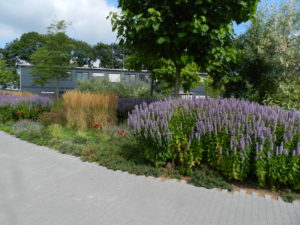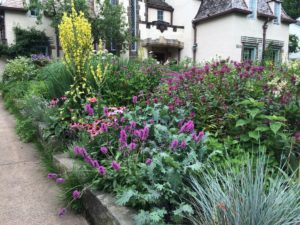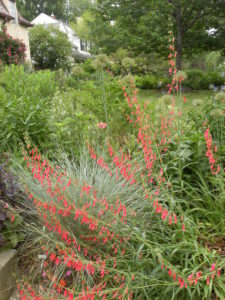During the winter, almost everyone, including gardeners, complains about the cold and the snow and exclaims that they can hardly wait for the arrival of spring flowers. However, once summer sets in and the temperatures mount into the eighties and nineties, only the hardiest gardeners are still working in their gardens. Thus, we hardy souls appreciate those plants that say, “Bring it on!” Such plants mean that we might be able to spend some time with a cold glass of our favorite beverage. Many heat loving plants are very drought tolerant but need dry, well-drained soil; however, two of my favorites appreciate some water.

Vignette of Spiraea ‘Magic Carpet’, Baptisia foliage, Rosa Oso Easy ‘Cherry Pie’, Allium christophii deadheads, and Heuchera ‘Georgia Peach’ on my west hill in mid-June
Rosa Oso Easy® Cherry Pie
I love roses but not if they have to be sprayed. Over the past ten years, I have become acquainted with several cultivars of the Oso Easy ® series, all of them disease-resistant and hardy in zones 4 to 9.
One of my favorites is Rosa Oso Easy® Cherry Pie, a cherry red with a hint of ruby. For bright color in the landscape from June until frost, it’s hard to beat. The only problem is that you can’t eat it. Grow it in full sun and give it water on a regular basis. In the fall, the bush usually has both flowers and hips. Although only two feet high, a mature plant does spread out to four feet. Prune back hard in spring to maintain its bushy habit.

Red lily adds color spice to Calamagrostis and Agastache ‘Blue Fortune’; taken at Floriade in August 2012

Agastache ‘Golden Jubilee’ between Penstemon ‘Dark Towers’, Salvia ‘Caradonna’ with Sedum ‘Autumn Charm’ in front; client garden taken 2 days ago
Agastache foeniculum ‘Blue Fortune’ (Blue Fortune Hyssop)
The genus Agastache has become much better known in the last decade for good reason. The species and cultivars bloom for a long time, love heat, and are never touched by deer and rabbits who hate the herbally, licorice taste. Hardy in zones 5 to 9, well-drained soil and full sun will ensure its viability. This hyssop grows two and a half to three feet tall with multiple lavender blue spikes in July and August above somewhat large, coarse green foliage. I frequently use its sister cultivar, ‘Golden Jubilee” which has all of the same attributes but adds yellow foliage. The spikes are large; thus, the plant benefits from deadheading, both to improve its appearance and to encourage more bloom on the laterals. Bees and butterflies are frequent visitors.
This is a good perennial to use in the back of a blue/purple/yellow border with either Penstemon ‘Dark Towers’ in the middle or Salvia ‘Caradonna’ at the front for all summer color. It could also be used with yellow and white perennials for a totally different color scheme.

Verbascum, flowering of Flowering Kale, Stachys monieri ‘Hummelo, Echinacea ‘Pixie Meadowbrite’, Monarda ‘On Parade’ and ‘Dark Ponticum’ in my garden last July
Verbascum bombyciferum ‘Polarsommer’ (‘Arctic Summer’)
This mullein is a knock-your-socks-off, stunning, architectural biennial. Put it in your front yard and people will be ringing your doorbell to find out what it is. During its first year of growth, the velvety silver leaves form a large (3’) rosette that will engulf any low perennials nearby. In its second year, look out! In June, a five foot, branched stalk will spring up, adorned with a multitude of small yellow flowers that, en masse, make quite an impact. It looks great combined with purples and other yellows or combined with hot colors.
Once the terminal stalk has finished blooming, prune it back to the laterals that will then emerge. Flowers will appear on them and on the lower branches. These secondary blooms continue well into August and September. One word of warning: This biennial is a prolific seeder so editing, i.e.weeding, will be required. I usually leave no more than three seedlings per year but dig the rest to give away or compost. This biennial is hardy in zones 4 to 8 and is extremely drought tolerant but thrives also with average moisture. Deer and rabbits ignore it.

Penstemon barbatus, Helictotrichon foliage, Echinacea foliage, Allium deadheads, Papaver somniferum in mid-June
Penstemon barbatus (Beardlip Penstemon)
In my old age, I have become an aficionado of bright colors and nothing fills the bill better than this penstemon. Native to the Southwest, it thrives in heat as long as it has extremely well-drained soil, especially during the winter when there is no heat to suck out the moisture. You, too, can achieve this type of soil by purchasing Turface, an enlarged aggregate, at a garden center. Dig in copious amounts of it. With the right soil, it will be hardy to zone 4.
The bright reddish-orange flowers stay in bloom for a very long time. They make quite a show in June and July. Then I cut them back and they rebloom in August and September. This year, I also have a seedling about a foot and a half away. Although technically Penstemon barbatus is eighteen to thirty-six inches high, the stems are quite lax resulting in a height of approximately twelve to eighteen inches. I love the way they spill over my driveway wall. The strong color can be softened by planting it near the steel blue ornamental grass Helictotrichon and countered with the white Allium nigrum.
If you need hardy, heat-loving plants, try some of these.


0 Comments